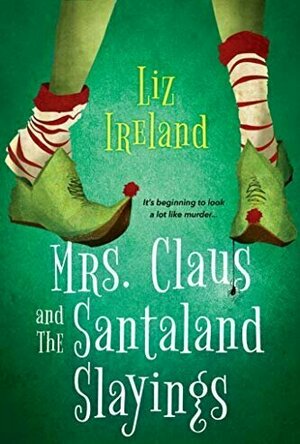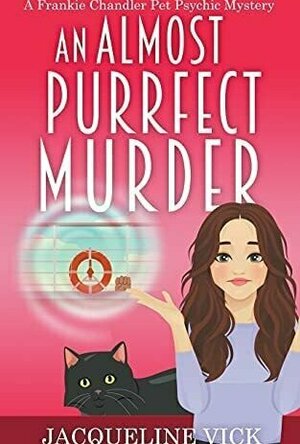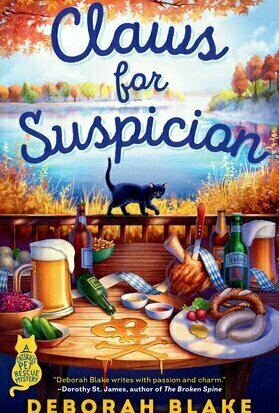Search
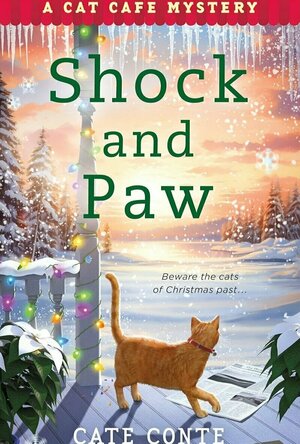
Shock and Paw
Book
The eighth installment in a charming cozy mystery series set on an island off the New England coast...
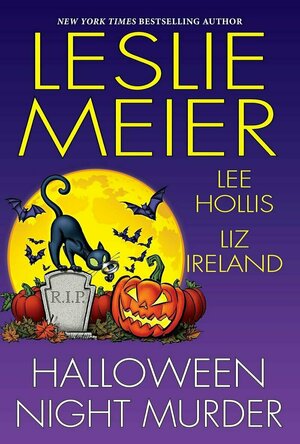
Halloween Night Murder
Leslie Meier, Lee Hollis and Liz Ireland
Book
There’s usually a chill in the air when Halloween arrives—but in these three novellas by beloved...
Mark @ Carstairs Considers (2460 KP) rated Watching the Detectives in Books
Sep 12, 2025
Decorating with a Dead Body Is Not Recommended
When this book opens, it’s been four days. Only four days since Ellison Russell was chased by a killer clown. Ellison has decided it is time to redecorate her husband’s study, and she’s brought in Khaki White, one of her potential boyfriend’s ex-wives. But Khaki is the go-to decorator among the country club set, so Ellison is getting a quote. That is until her housekeeper calls with car trouble, and Ellison runs out to get her. The two women return to find Mrs. White dead in the study, shot by a revolver. Can Ellison navigate the latest dead body in her life?
It has been too long since I read the previous book, but I was quickly back in Ellison’s world. I enjoyed seeing what was going on with the characters, and I’m hopeful the love triangle has been put to rest. Her mother wasn’t quite as overbearing in this book, which was appreciated. The 70’s are brought to life with plenty of great details, and some of the politics of the day. Fortunately, the content the series has had that keeps it just outside of cozy for me was toned down in this book. The mystery gets a little sidetracked, and the ending is weaker than I like, but it still kept me going. Ellison’s dry wit narration is a delight and keeps me smiling if not laughing. Hopefully, it won’t be so long before I revisit the characters.
It has been too long since I read the previous book, but I was quickly back in Ellison’s world. I enjoyed seeing what was going on with the characters, and I’m hopeful the love triangle has been put to rest. Her mother wasn’t quite as overbearing in this book, which was appreciated. The 70’s are brought to life with plenty of great details, and some of the politics of the day. Fortunately, the content the series has had that keeps it just outside of cozy for me was toned down in this book. The mystery gets a little sidetracked, and the ending is weaker than I like, but it still kept me going. Ellison’s dry wit narration is a delight and keeps me smiling if not laughing. Hopefully, it won’t be so long before I revisit the characters.
Mark @ Carstairs Considers (2460 KP) rated Guaranteed to Bleed in Books
Jun 10, 2020
Guaranteed to Entertain
Ellison Russel is spending this particular Friday night in September 1974 at a high school football game. Not because she loves the sport, but because her daughter, Grace, is a cheerleader. Unfortunately, early in the second half, she stumbles on Bobby Lowell who begs Ellison “Tell her I love her” before he dies. Bobby and Grace grew up together, so the murder hits close to home. Ellison isn’t trying to solve things, but she can’t help but figure it out as she tries to figure out who the mysterious woman is. Will she pass on Bobby’s message? Will she find the killer?
I’m glad I was finally able to return to Ellison’s world. The story is strong. It doesn’t unfold in typical cozy mystery fashion, but that didn’t bother me. I got more and more involved the further into the book I got. Ellison is a great main character, and I loved watching the growth in the character here. The rest of the cast is also great, although I wish her Mother weren’t so focused on everything being perfect. I find it funny at times, but it can be annoying. The book walks a fine line between humor and more serious themes, and the result is rich. The book does venture into some PG-13 topics, but know that going into the book and you’ll be fine since it never gets too graphic. I do recommend reading book one before you read this one since it includes fallout from the events of that story. Hopefully, it won’t be so long before I visit Ellison again.
I’m glad I was finally able to return to Ellison’s world. The story is strong. It doesn’t unfold in typical cozy mystery fashion, but that didn’t bother me. I got more and more involved the further into the book I got. Ellison is a great main character, and I loved watching the growth in the character here. The rest of the cast is also great, although I wish her Mother weren’t so focused on everything being perfect. I find it funny at times, but it can be annoying. The book walks a fine line between humor and more serious themes, and the result is rich. The book does venture into some PG-13 topics, but know that going into the book and you’ll be fine since it never gets too graphic. I do recommend reading book one before you read this one since it includes fallout from the events of that story. Hopefully, it won’t be so long before I visit Ellison again.
Mark @ Carstairs Considers (2460 KP) rated Mrs. Claus and the Santaland Slayings in Books
Sep 30, 2020
Murder at the North Pole
April’s life changed completely when she learned Nick, the man she had fallen in love with, was Santa Claus. Now, she’s spending her first Christmas at the North Pole as Mrs. Claus. However, the stress of the holiday is nothing compared to the death of an elf. Giblet Hollyberry was not an especially popular elf, but his death comes the day after he had a very public fight with Santa. While the rest of the Claus clan doesn’t seem that concerned, April worries that the evidence is pointing toward her new husband. The North Pole isn’t normally a hotbed of crime, but it seems someone is doing their best to put Santa on the naughty list this year. Can April keep that from happening?
At its heart, this book is a cozy mystery, and it is a wonderful one. There are enough suspects, secrets, and clues to keep the reader engaged the entire way through the book. It’s the setting that makes the book stand out, and it is wonderfully done. It took me a bit to get the pictures from countless specials and movies out of my head, but April’s new world soon came fully to life for me. The characters, whether they are human or not, are very real, and I enjoyed meeting them here. And the book is overflowing with Christmas cheer – so much so that I had to start listening to some Christmas music while I was reading it. This book definitely deserves a place at the top of your nice list. I’m already looking forward to the sequel.
At its heart, this book is a cozy mystery, and it is a wonderful one. There are enough suspects, secrets, and clues to keep the reader engaged the entire way through the book. It’s the setting that makes the book stand out, and it is wonderfully done. It took me a bit to get the pictures from countless specials and movies out of my head, but April’s new world soon came fully to life for me. The characters, whether they are human or not, are very real, and I enjoyed meeting them here. And the book is overflowing with Christmas cheer – so much so that I had to start listening to some Christmas music while I was reading it. This book definitely deserves a place at the top of your nice list. I’m already looking forward to the sequel.
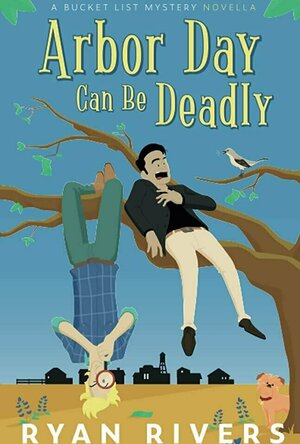
Arbor Day Can Be Deadly
Book
He came to stay out of trouble. But when a new friendship pulls him deep into danger, can he make it...
Mark @ Carstairs Considers (2460 KP) rated An Almost Purrfect Murder in Books
Jul 30, 2022
Who Committed Murder on an Alaskan Cruise?
A cruise to Alaska isn’t Frankie’s idea of a vacation, but when her best friend, Penny, decides to get married in the middle of a cruise, she goes along, especially since she’s the maid of honor. The first night, Frankie watches the entertainment, which includes a cat trainer. She surprised to find one of the cats outside her door the next morning transmitting some weird messages that only begin to make sense when she finds the dead body of the trainer on the lifeboat below her cabin. Can she convince anyone that he was murdered?
In a moment of serendipity, I read this book on an Alaskan cruise I took recently. It was fun and strange to read about Frankie in places I was visiting, just in a different order. Yes, this is one of the few paranormal cozy series I read since Frankie can communicate with animals, but it’s a minor part of the story. The plot was uneven with the wedding and romantic subplots taking up pages as well. Since the book is the third in the series, I was definitely invested in those stories, but a little more time on the mystery would have been nice. Still, I was impressed with how all the clues came together in the end. Most of the characters were new, and I enjoyed getting to know them, suspects and family members alike. I laughed multiple times as I was reading at the antics of the two and four legged characters. Overall, this is a fun book that fans of the series will enjoy.
In a moment of serendipity, I read this book on an Alaskan cruise I took recently. It was fun and strange to read about Frankie in places I was visiting, just in a different order. Yes, this is one of the few paranormal cozy series I read since Frankie can communicate with animals, but it’s a minor part of the story. The plot was uneven with the wedding and romantic subplots taking up pages as well. Since the book is the third in the series, I was definitely invested in those stories, but a little more time on the mystery would have been nice. Still, I was impressed with how all the clues came together in the end. Most of the characters were new, and I enjoyed getting to know them, suspects and family members alike. I laughed multiple times as I was reading at the antics of the two and four legged characters. Overall, this is a fun book that fans of the series will enjoy.

Aerobics Can Be Deadly
Book
When this odd couple signs up to be extras in a fitness video, it's lights, camera... murder. Sho...
Mark @ Carstairs Considers (2460 KP) rated Claws for Suspicion in Books
May 4, 2022
Kari’s Life is Upended Before Murder
The shelter that Kari Stuart bought when she won the lottery is finally in great shape. However, all that is threatened when Kari’s ex-husband shows up in town. Charlie Smith arrives baring the news that there was a mistake with their divorce, and they are technically still married. As a result, he is entitled to half Kari’s winnings. Or, he will settle for the land the pet shelter is on. Kari has no interest in giving Charlie anything, so she starts trying to figure out how to get him to go away. Then he dies, and his death looks like murder. The police view Kari as their prime suspect since she is the only one in town with a motive. Can Kari convince them that someone else killed Charlie?
While the ex coming back to town isn’t a new plot element in a cozy mystery, Charlie’s motives and the complications are definitely fresh here. I did feel the plot stalled a bit before Charlie actually died, although it was setting up motives and suspects before it happened. Once it did, Kari followed a logical set of clues to the climax. I always appreciate how well things are laid out when I reach the end of the books in this series. I love Kari’s circle of friends, and it was wonderful to spend time with them again. The suspects fit wonderfully into the world. Naturally, there’s plenty of animal cuteness here as well. Fans of the series will be happy with this book, and if you haven’t started it yet, you’ll be happy you picked up one of the books.
While the ex coming back to town isn’t a new plot element in a cozy mystery, Charlie’s motives and the complications are definitely fresh here. I did feel the plot stalled a bit before Charlie actually died, although it was setting up motives and suspects before it happened. Once it did, Kari followed a logical set of clues to the climax. I always appreciate how well things are laid out when I reach the end of the books in this series. I love Kari’s circle of friends, and it was wonderful to spend time with them again. The suspects fit wonderfully into the world. Naturally, there’s plenty of animal cuteness here as well. Fans of the series will be happy with this book, and if you haven’t started it yet, you’ll be happy you picked up one of the books.
graveyardgremlin (7194 KP) rated On What Grounds (Coffeehouse Mystery, #1) in Books
Feb 15, 2019
On What Grounds is a good start to this series, but not great by any means. The mystery was lacking and there weren't enough clues for the reader to even get close to figuring out whodunnit or why. The explanations about the different types of coffee are very interesting, but come close to taking over the storyline. Some of the things I did not like about the writing style, were that, at times, the writing could be condescending, such as a Tanya Harding example that didn't sound natural and seemed to imply that the reader has been living in a cave for the last twenty or so years, then there's the backtracking into past events for around twenty pages and then returning to the cliffhanger which is where we left off of and then trying to remember where that was exactly (ugh! Sorry, but doing that three or four times is unnecessary and annoying), and the end was way to preachy about Anabelle's life and choices - this isn't an after school special or a Lifetime movie, get over yourselves (the authors that is :P). Another thing (yes there's more!), I don't like the love triangle aspect. For the most part, an ex should stay an ex (I know there are some exceptions, but that's just my preference in this case), and I much prefer Quinn, who I really hope isn't married.
Oh, and one more thing... I took a little offense to the disdain of decaf drinkers. I just don't handle caffeine that well - yes, I might be an anxious person, but I don't have imagined allergies or neuroses or whatever else she describes most decaf drinkers as. Not to mention, it makes me very shaky, in a bad way, and I cannot fathom drinking as much coffee as she does all the time - I need sleep! LoL Yes, I'll imbibe in coffee that isn't decaf, but for the most part, I'd rather have decaf. Gotta problem with that?! :P
What I did like...
Clare - some other reviews I've read have been iffy about her, but I blame how the authors wrote the book.
Java - I know it's a cozy mystery cliche, but I love cats in books. :)
Learning about coffee - it's really rather interesting.
Recipes - gotta love those!
The promise of a good series - the writing overall is good and I hope that now that most of the history has been written about, the next books will flow better.
Oh, and one more thing... I took a little offense to the disdain of decaf drinkers. I just don't handle caffeine that well - yes, I might be an anxious person, but I don't have imagined allergies or neuroses or whatever else she describes most decaf drinkers as. Not to mention, it makes me very shaky, in a bad way, and I cannot fathom drinking as much coffee as she does all the time - I need sleep! LoL Yes, I'll imbibe in coffee that isn't decaf, but for the most part, I'd rather have decaf. Gotta problem with that?! :P
What I did like...
Clare - some other reviews I've read have been iffy about her, but I blame how the authors wrote the book.
Java - I know it's a cozy mystery cliche, but I love cats in books. :)
Learning about coffee - it's really rather interesting.
Recipes - gotta love those!
The promise of a good series - the writing overall is good and I hope that now that most of the history has been written about, the next books will flow better.


